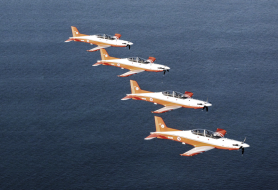TECH EDGE IN PILOT TRAINING
PHOTO // Michelle Loh and Courtesy of 130 SQN
Despite the bright orange hue of their aircraft, 130 Squadron's (130 SQN's) Pilatus PC-21 trainer aircraft is no toy, but an important part of the RSAF s fleet.
The tandem-seat turboprop PC-21, which boasts top-of-the-line aerodynamic performance and advanced avionics, also possesses a full-glass cockpit environment fitted with three active-matrix liquid crystal displays to mimic modern jet fighters.
Based at the Flying Training Institute (FTI) in the Royal Australian Air Force (RAAF) Base Pearce, Perth, Australia, 130 SQN is in charge of conducting the nine-month Basic Wings Course (BWC) which all pilots have to undergo.
The rigorous and realistic training programme of the BWC, which consists of lectures, simulator training and flying the PC-21, evaluates the trainee pilots from Day One of their training programme. All this is done with the ultimate aim of assessing the trainee pilots' flying aptitude and building a strong foundation in flying fundamentals.
Developing capable pilots
Using technology as leverage, trainee pilots of 130 SQN hone their skills through relevant and realistic training.
Highlighting the importance of using technological advances to improve the RSAF's training capabilities, Commander Air Force Training Command (AFTC), Colonel (COL) Yeo Yee Peng told PIONEER: "Today, technology has progressed tremendously, such that there is a full suite of sensors and systems to enhance our operational readiness and capabilities"
"In order for us to train our pilots efficiently, we utilise advanced trainer aircraft such as the Pilatus PC-21 and the incoming M-346 to help trainee pilots develop the aptitude to handle critical situations as well as perform well in missions that they may be called upon to undertake in the future."
Likewise, the RSAF uses simulator training systems with high-fidelity graphics and realistic elements to help its trainee pilots develop the necessary flying capacity and skills without compromising on flight safety.
Lockheed Martin Simulation, Training and Support (LMSTS) supplies and maintains the RSAF s PC-21 fleet and a suite of ground-based training systems in 130 SQN, as part of a BWC training package developed through a Ministry of Defence Public-Private Partnership arrangement.
Emphasising that the BWC aims to produce trainee pilots with robust flying fundamentals and sound character traits, Commanding Officer of the RSAF's 130 SQN, Lieutenant Colonel Eric Wee, said: "We believe strongly in developing trainee pilots such that they possess the core values, critical thinking abilities, confidence and good presentation skills of an officer in the 3rd Generation RSAF when they leave the squadron."
In an effort to engage the trainee pilots regularly, the squadron has in place a mentorship programme that pairs trainee pilots with experienced pilots for better sharing and guidance. Additionally, the senior management involves the trainee pilots and junior officers in the operational aspects of the squadron where possible for co-learning opportunities.
For instance, the trainee pilots take turns to sit in during squadron safety discussions held by its safety committee with senior officers, so that they can share what they have learnt with their fellow trainee pilots.
Overcoming space constraints
The RSAF signed a Memorandum of Understanding with the RAAF to establish the FTI at RAAF Base Pearce in March 1993. This is on top of the other training arrangements Singapore has with Australia, such as the use of the Shoalwater Bay Training Area, and is indicative of the close and long-standing bilateral defence relations between the two countries.
Explaining how training overseas has allowed the RSAF to overcome airspace constraints in Singapore, COL Yeo said: "To build the pilots' capabilities and flying skills, we have to leverage on overseas exercises and permanent detachments, such as 130 SQN, to train our pilots in realistic and challenging flying profiles, to produce the highly professional and competent 3rd Generation airmen needed to operate the RSAF's technologically-advanced platforms and systems"
He added: "Overseas training also allows the RSAF to benchmark and operate with some of the more established air forces, and we have gained many useful
platforms for the RSAF to deepen defence relationships with our international counterparts."
In addition, 130 SQN has in place a Qualified Flying Instructor exchange programme with the RAAF, which allows both sides to share best practices and enhance pilot training modalities.
Many of the Singaporean trainee pilots and their Australian counterparts have also struck up lasting friendships through communal sports at the base field, daily lunches and other social gatherings.
"To build the pilots' capabilities and flying skills, we have to leverage on overseas exercises and permanent detachments, such as 130 SQN, to train our pilots in realistic and challenging flying profiles."
- COL Yeo,Commander Air Force Training Command










